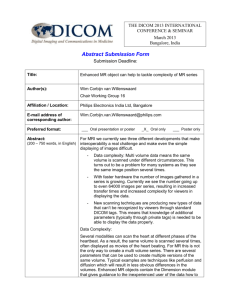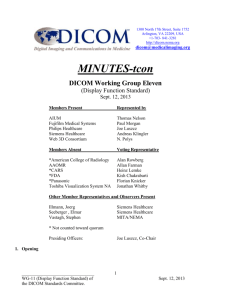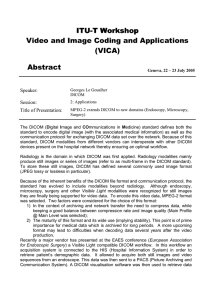Data Transfer Concepts for Electronic Charting R. Alfredo C. Siochi, PhD
advertisement
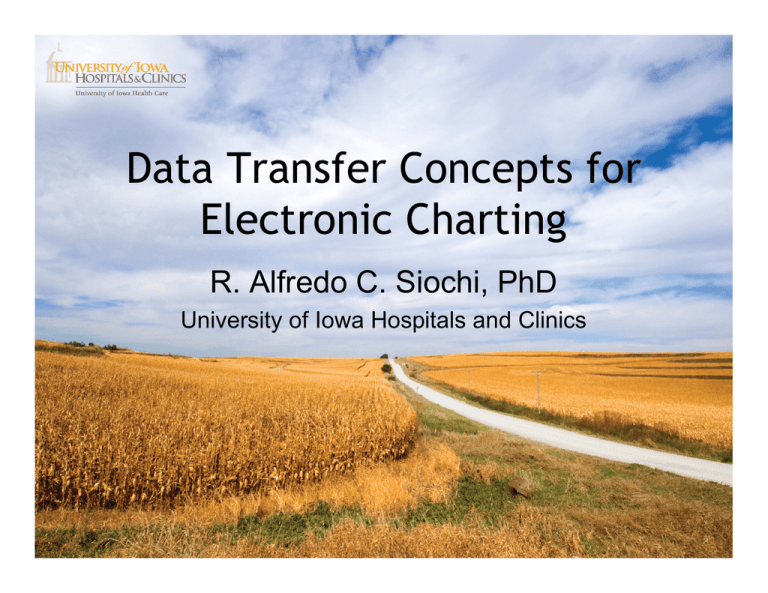
Data Transfer Concepts for Electronic Charting R. Alfredo C. Siochi, PhD University of Iowa Hospitals and Clinics Outline 1. IT Infrastructure a) Networks – physical structure b) Transport Protocols c) DICOM, HL7 2. Data Repositories a) File Systems b) Databases 3. Models of Data Flow a) Distributed b) Centralized c) Examples Outline-II 4. Data Transfer Matrix a) Subsystems in Rad Onc b) Example Matrix c) Testing 5. Quality Assurance and Control Basics a) Principal concepts: Physical Integrity and Logical Consistency b) ATP and Commissioning c) Annual d) Patient QC Networks • Link computers together – Including computers that drive treatments! – Can be across continents • Various architectures possible • Rad Onc should be behind a firewall • Connections: cables, optical fiber, routers, “wireless”… Network Diagrams Is Your Rad Onc Network Here ? Mailman analogy • • • • • • Houses = computers House Address = ip Address Residents = ports Post office = finds appropriate routes Roads = cables / wireless The analogy breaks down with the lower layers… OSI 7 layers • Physical through Logical • package up the information for sending • Analyze the package for receiving • Transport information – Computer: ip address – Software Application: port • DICOM layer: AE title Open Systems Interconnect Translate, Encrypt, Compress Establish, Maintain, Synchronize interactions Split message into smaller parts Packets from origin to destination, logical-physical address mapping Decompress, Decrypt, Translate Entire message reassembled, origin to destination Node to node transmission of data frames TCP/IP - OSI Entire data stream SMTP (mail), HTTP (web), FTP, Telnet Packets framed with header (addresses, error checking) TCP Determine routing and add IP header IP Ethernet, etc IP frame transmission DICOM, HL7 • • • • Primary protocols in a hospital setting TCP/IP DICOM-RT: RT treatment data HL7: Admissions, Discharge, Transfer, labs, billing…. Information vs Data • Data are associated with attributes • There should be enough attributes to be unambiguous Value 99 attribute ? information ? age A very old person Code number Maxwell Smart’s sidekick? Weight May be light or heavy. Lbs or Kg? Attributes determined from: • DICOM: Information Object Definition (IOD) • HL7 – message headers and expected record position within the message DICOM Applications • Picture Archiving and Communications System (PACS) • DICOM-RT capable treatment planning systems, for export to R&V and IGRT systems • DICOM from imaging systems to treatment planning systems Making the Connection http://worldrec.info/2006/10/26/the-worlds-messiest-network-cable-arrangements I hope your DICOM “physical layer” looks better than this! A DICOM network uses the underlying TCP/IP infrastructure. Application Entities (AEs) • Software application residing on a computer with a static IP address • Default port 104 • or any unused port as long as receivers and senders use the same one • Other configurations possible but more complex The quad core AE knows about the Coherence workstation ONC05PHYSICS Coherence knows about the quad core AE and its supported Dicom Services ASSOCIATIONS • A handshake, a dialogue to make a contract • Check that AEs are compatible – Able to perform requested service • Ensure AEs agree on data transfer – Have at least one common transfer syntax Services • An AE can be a – Service Class Provider (SCP) – Service Class User (SCU) • SCP responds to request of SCU to provide a service: – Service Object Pair (SOP = command + IOD) • CT image Storage = C-Store (push) + CT image • Commands (DICOM Message Service Elements, DIMSE): C-Find, C-Echo (ping), C-Move or C-Get (pull) What gets transferred? Protocol data unit = PDU Data set logically comprised of data elements Information about data elements are found in the data dictionary by using the tag Optional for Implicit VR transfer syntax From “Informatics in Radiation Oncology”, eds. Siochi and Starkschall, – Ch. 11, Information Resources for Radiation Oncology by R.A.C. Siochi- In Press. Data set broken into PData TF PDUs for communication only What happens after the transfer ? Depends on your AE: • Bytes stored in proprietary format in a proprietary database known only to the AE • Bytes stored in DICOM part 10 format as a dicom file in a proprietary database. – Essentially a “transcript” of the dicom transfer – Includes a metafile to handle transfer syntax • Part 10 format file stored in a folder • DICOM file service is used to store part 10 format files (becomes abstract to media storage) • *.dcm, *.ima – let’s take a closer look… Excerpt from a Data Dictionary Value Multiplicity – The number of items in this data element, separated by “\” for character strings Tag: Hexadecimal, 2 bytes each for group and elementunique identifier for the attribute From “Informatics in Radiation Oncology”, eds. Starkschall and Siochi, – Ch. 11, Information Resources for Radiation Oncology by R.A.C. Siochi- In Press. Value Representation (unsigned short) A stream of words or bytes Using the Data Dictionary • IF your application can’t read a Dicom file, it might have encountered a data element whose tag is not listed in the application’s dictionary • Implicit VR: VR must be determined from a Dictionary • Converting the data into human readable form requires getting the Item name from the Dictionary (to serve as a label) DICOM-RT • Uses the same paradigm for data elements, file structure and communication • Several Modules – – – – – – – – – – – – – – – – – – – – – – RT Series RT Image (conical imaging geometry) RT Dose RT DVH Structure Set RT-Plan Modules for external ROI Contour RT Dose ROI RT General Plan* RT Prescription* RT Tolerance Tables* RT Patient Setup* RT Fraction Scheme* RT Beams* RT Brachy Application Setups Approval RT General Treatment Record RT Treatment Machine Record RT-Record Modules Measured Dose Reference Record Calculated Dose Reference Record RT Beams Session Record RT Brachy Session Record RT Treatment Summary record beam treatments DICOM-RT Modules • Designed to completely describe – Treatment Plan – Delivered Treatments • References associated Images • Some images may be the planning images (CT, MR) that were used for contouring • Others may be RT Images (DRRs, portal images, CBCT). RT-Plan • Probably most important DICOM RT IOD to know • Used by some systems for export/import to/from Record & Verify • Not easy to read even when put in “humanreadable” form – Too many references – Doesn’t easily fit our pre-conceived treatment beam model – IEC 61217 coordinate conventions • Need applications to convert it into something that we are used to seeing (e.g. MUs belong with the field, native coordinates) Clinical Issues in RT • DICOM is used to transfer plan information from the TPS to the R&V and IGRT systems • If there is a problem with the transfer, how do you troubleshoot it? • If you need to extract other information, what do you do? • Need DICOM aware applications • DICOM readers, viewers, editors • DICOM servers DICOM software • Do a Google search • DICOM + – – – – – Viewer Reader Server Anonymizer Editor • They may not do all that you want nor how you want it done • Shop around, test drive them • Also, see what your TPS or RT-PACS can do Example: Connectivity • Archive A was retired and Data was transferred to Archive B. • Archive B would not accept a particular study with CT Images from Archive A • Archive A sent the study to CONQUESTSRV1 • CONQUESTSRV1 sent the study to other stations where it was needed (could not be pushed to or pulled by Archive B, however.) HL7 • Primarily for Hospital Information Systems • Main issue for Rad Onc: demographics, scheduling, billing. • Synchronize hospital data with Rad Onc Information System / EMR/TMS (e.g. Mosaiq, Aria) Example HL7 message MSH|^~\&|CLOVERLEAF|UIHC|LANTIS|UIHC|201301081413||BAR^P01|62830_33_RE|P|2.3||||||ASCII EVN|P01|201301081413|||JEG475 PID|1||05979249^^^IDX||DOE^JANE||19800302|F|||123 45TH ST^^MARION^IA^52302-1234^US PV1|001 4 Segments in this message: MSH = Message Header EVN = Event type PID = Patient Demographics PV1 = Patient Visit Information PID segment made of several fields | separates fields Sequence of fields determines the meaning e.g. 5th field is the patient’s name HL7 transmission • TCP/IP • Minimal Lower Layer Protocol • Add a message header and footer to delimit messages • Use ACK(nowledgment) and NAK messages • HL7 TCP/IP listener/router application • Sender sends to Listener’s IP/port HL7 Issues • • • • • Messaging System Needs a log of transactions Needs a mechanism to verify uptime Mechanism is on sender and listener end Example Error: System down, lab results not sent, physician assumed labs OK, and a patient died as a result. HL7 and Rad Onc • Primarily demographics • Name and Birthday are critical identifiers • How do you know if you have the right patient? • Verify patient registration in RO EMR with patient Data Repositories • Once Data has been generated or transported, where do they go? • Folders / Files – directories on the hard drive – Example: Pinnacle plan.trial file holds all the treatment plan information • Databases – Example: EPIC, MOSAIQ, ARIA File System Databases Database basics • • • • DB consists of Tables Table: consists of rows (aka records) Row: contains column elements (aka fields) Queries – E.g. how many patients had IMRT this month? – SQL (Structured Query Language) 38 DB Tables Primary Key must be unique Field or Column Names define the table T_ID First Last 45 Alpha 72 73 SSN MRN License Omega 123456789 123 abc Primero Ultimo M 987654321 456 def Alias Omega 123456789 123 abc Record (row) Field (column) MI Normalization P_ID First Last 45 Alpha Omega 72 73 Primero Ultimo Alias Omega MI F_ID M P_ID SSN MRN License 29 29 123456789 123 abc 37 37 987654321 456 def 29 Foreign Keys point to a record in a related table Normalization avoids useless repetition, update anomalies, data loss…. 40 Typical Tables in an RT DB In order to “incorporate” tables into other tables, foreign keys are used to point back to the related tables. Here, each record in the Tx_Fields table consists of parameters that describe Linac settings. One of the parameters, control points, is a set of records in another table, with a “foreign key” that points back to the Tx_Field record to which it belongs. DATA DICTIONARY – provides the definitions of the tables and the relationships among them. 41 Data Flow in RO *Fig. 11.1 from Siochi, Information resources for radiation oncology, Ch. 11 of a forthcoming book: Informatics in Radiation Oncology, G. Starkschall, R. Siochi, editors. 42 Distributed system data flow Redundant data living in many places: INFORMATION should match. (Data might be stored in different forms but mean the same thing.) 43 Centralized DB dataflow Multiple applications accessing the same data at different times: They should synchronize! 44 Examples • Distributed – Pinnacle transfers RT plan to MOSAIQ – MOSAIQ transfers RT plan to Linac Console • “Centralized” – Eclipse RT plan is created, using Aria to hold the RT plan database elements – …hybrid… still have to transfer to 4D ITC. Why should it matter what I have? • Affects testing because of data state • Centralized DB has to deal with concurrency issues and caching. • Distributed DB has to deal with data transfer errors and updates to all systems for changed data Data Transfer Matrix • Table with 1st column containing source • 1st row containing destination • The cell at an intersection is the data to be transferred Typical elements of the matrix • • • • • • Simulation System (SS) Treatment Planning System (TPS) Treatment Management System (TMS) Treatment Delivery System (TDS) Image Guidance System (IGS) Picture Archiving and Communication System (PACS): The PACS allows for the electronic storage of images. • Archiving System (AS): storage of a patient’s entire treatment history. Example Matrix Table I: An example data transfer matrix. The row and column headers provide the source and destination subsystems, respectively. The matrix element at a row and column intersection contains the data to be transferred. Destination Source SS SS TPS TMS Images TPS Plan, Images Plan, Images RT Plan-fields TDS Recorded treatment Images Plan, Images AS Images TMS AS TDS Database backup Database backup Testing • Every cell in the data transfer matrix needs to be tested • Some parts of tests could be used to test many cells (e.g. cells in the same row) • Design efficient tests to exploit common features Quality Assurance and Control Basics • Principal concepts: – Physical Integrity – Logical Consistency • ATP and Commissioning • Annual • Patient QC Principal Concepts • Data Integrity – Are the bits and bytes intact? – Typically checked with a CRC – Were the transferred bits interpreted as the correct information? • Logical Consistency – Are related pieces of information consistent with each other? ATP and Commissioning • ATP – typically done with the vendor – Might be limited to subsystem – Make sure to specify data transfer testing as part of the ATP at time of purchase • Commissioning – Where data becomes information – Typically enter coordinate systems, preferences – Test data transfer matrix row for the subsystem Annual • Somewhat of a misnomer • Should really be done anytime a system is changed • If none of your systems change after a year, just test hardware for functionality/efficiency • Might be a good idea to hold off on software updates until several can be combined Testing: Quality Assurance • System Tests • equipment meets specs • Given input produces expected output Can you really dial 999? Quality Control • • • • Inspects each service Or intermediate product Or items on an assembly line What we generally refer to mistakenly as QA in “patient-specific QA” Testing: Quality Control Caffeinated Jelly Bean Inspector Data Transfer QC • Done for every patient • Done for every transfer of data • Check for Logical Consistency and Data/Information Integrity. Information Integrity • Generally a manual check • Some places have automated systems Manual vs Automated Check TMS TMS TPS TPS Manual Comparison of Printouts or Screens Software Compares Data Sources Logical Consistency • Mostly manual process • Can be automated to some extent • Example: a prescription calls for a treatment using 6x, but there is a 10x treatment beam within the prescription Clinical Interactions, paperless checks Physicists Dosimetrists/Physicians Therapists In-House Software Adapted from Fig 5. Siochi, et al. Radiation therapy plan checks in a paperless clinic, J. App. Clin. Med. Phys., 10(1):43-62. 63 Thank you!
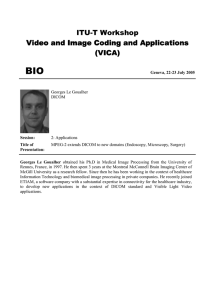
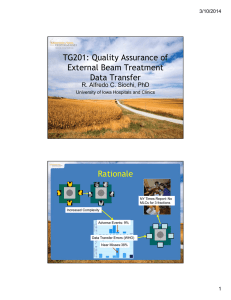
![[#MIRTH-1930] Multiple DICOM messages sent from Mirth (eg 130](http://s3.studylib.net/store/data/007437345_1-6d312f9a12b0aaaddd697de2adda4531-300x300.png)

